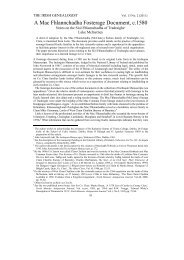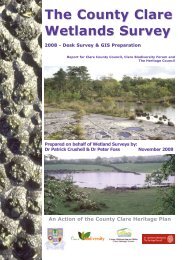Documents from the Thomond Papers at Petworth House Archive1 ...
Documents from the Thomond Papers at Petworth House Archive1 ...
Documents from the Thomond Papers at Petworth House Archive1 ...
Create successful ePaper yourself
Turn your PDF publications into a flip-book with our unique Google optimized e-Paper software.
Archivium Hibernicum<br />
and Teig McBrodyn’, 140 members of <strong>the</strong> celebr<strong>at</strong>ed Mac Bruaideadha<br />
learned family, court poets to <strong>the</strong> earl. 141<br />
The employment of learned Gaelic liter<strong>at</strong>i speaks volumes about <strong>the</strong><br />
social context th<strong>at</strong> <strong>the</strong> earl oper<strong>at</strong>ed in during <strong>the</strong> first decade of <strong>the</strong> seventeenth<br />
century; <strong>the</strong> old Gaelic order, while in decline, still constituted<br />
<strong>the</strong> cultural milieu th<strong>at</strong> even an anglicised Gaelic magn<strong>at</strong>e such as <strong>the</strong> earl<br />
recognised. The 1606 indenture also stipul<strong>at</strong>ed th<strong>at</strong> in <strong>the</strong> event of <strong>the</strong><br />
lands occupied by <strong>the</strong> Uí Mhaol Dhomhnaigh being offered in mortgage<br />
or any o<strong>the</strong>r conveyance, <strong>the</strong>y are to be first offered to <strong>the</strong> earl. In like<br />
manner, if any of <strong>the</strong> ‘Malowns shall die without lawful issue and heirs<br />
<strong>the</strong>n all <strong>the</strong>ir possessions, lands, tenements…remain to <strong>the</strong> said Earl and<br />
his heirs’. The Uí Mhaol Dhomhnaigh sept agreed to <strong>the</strong> same charges<br />
levied on <strong>the</strong>ir half of <strong>the</strong> land as th<strong>at</strong> of <strong>the</strong> earl. The indenture set down<br />
<strong>the</strong> sum of £200 sterling for <strong>the</strong> conveyed lands.<br />
Sir Barnaby refused <strong>the</strong> offer to transact <strong>the</strong> lands of ‘Gleanomalun’<br />
and ‘Clonfada’ in Killaloe parish. 142 His gave as his principal reason th<strong>at</strong><br />
<strong>the</strong> lands were ‘conveyed [to] me by my fa<strong>the</strong>r and forsoever <strong>the</strong> Malownes<br />
complained to your lord’. Sir Barnaby made <strong>the</strong> point th<strong>at</strong> his fa<strong>the</strong>r ‘did<br />
deal nobly in wh<strong>at</strong> he undertook’ and th<strong>at</strong> he loa<strong>the</strong>d to part <strong>from</strong> anything<br />
his fa<strong>the</strong>r, <strong>the</strong> fourth earl, had left him and hence was ‘forborne to set any<br />
price’ on <strong>the</strong> lands. Sir Barnaby was conscious th<strong>at</strong> Sir Dermot wanted <strong>the</strong><br />
‘plough land as having rel<strong>at</strong>ion to [his] barony’ and curiously acknowledges<br />
th<strong>at</strong> <strong>the</strong> Protestant Bishop of Killaloe coveted <strong>the</strong> lands also, presumably<br />
as <strong>the</strong>y fe<strong>at</strong>ured as temporal lands of <strong>the</strong> bishopric. 143<br />
The last document is a copy of <strong>the</strong> agreement drawn up for <strong>the</strong> purpose<br />
of Sir Dermot being conveyed <strong>the</strong> remaining lands of <strong>the</strong> Uí Mhaol<br />
Dhomhnaigh sept in his capacity as ‘chief and supreme of [<strong>the</strong>] sept’. 144<br />
The sign<strong>at</strong>ories to <strong>the</strong> deed were <strong>the</strong> ‘co-heirs’ of <strong>the</strong> sept 145 (agn<strong>at</strong>ic kin-<br />
140 Teig McBrodyn fe<strong>at</strong>ured in a land transaction also in 1606, in which he was enfeoffed by<br />
leading members of <strong>the</strong> Mac M<strong>at</strong>hghamhna lineage on 3 ½ quarters of land in Clonderalaw.<br />
His residence was given as ‘Corkanalabuna’ (Knockanalban) in Kilmurry Ibrickan parish.<br />
John Ainsworth (ed), The Inchiquin Manuscripts, p. 303. On <strong>the</strong> Mac Bruaideadha literary<br />
activities see Bernadette Cunningham, ‘The historical annals of Maolin Óg Mac Bruaideadha,<br />
1588–1603’ in The O<strong>the</strong>r Clare, xiii (1989), pp 21–24.<br />
141 Brian Ó Cuív, ‘An elegy on Donnchadh Ó Briain, fourth earl of <strong>Thomond</strong>’ in Celtica, xvi<br />
(1984), pp 87–105.<br />
142 See his letter, PHA Ms C.6/4<br />
143 Rev. Philip Dwyer, The Diocese of Killaloe <strong>from</strong> <strong>the</strong> Reform<strong>at</strong>ion to <strong>the</strong> Eighteenth Century,<br />
p. 137. Gleanomalun was recorded as temporal land belonging to <strong>the</strong> Bishopric of Killaloe<br />
th<strong>at</strong> were detained by secular p<strong>at</strong>rons in 1622. In Killaloe parish <strong>the</strong> lands included:<br />
‘Glanamuntermalone, Finleh, Ballinreehy or Balliduffy, Craiglegh, Balliteig, Clonfadda,<br />
Lickinbana’. The Earl of <strong>Thomond</strong> was recorded as <strong>the</strong> detainer of ‘Glanamuntermalone’.<br />
144 (PHA Ms C13/34a).<br />
145 This reference implies partible inheritance (Irish ‘gavelkind’) oper<strong>at</strong>ing amongst Gaelic<br />
freeholders in Co. Clare during <strong>the</strong> sixteenth century. On a discussion of partible inheritance<br />
in <strong>Thomond</strong> see Kenneth W. Nicholls, ‘Land, Law and Society in Sixteenth Century Ireland’,<br />
(Dublin, 1976), pp 3–26, p. 18. O<strong>the</strong>r Gaelic land practices such as redemption were practiced<br />
32

















